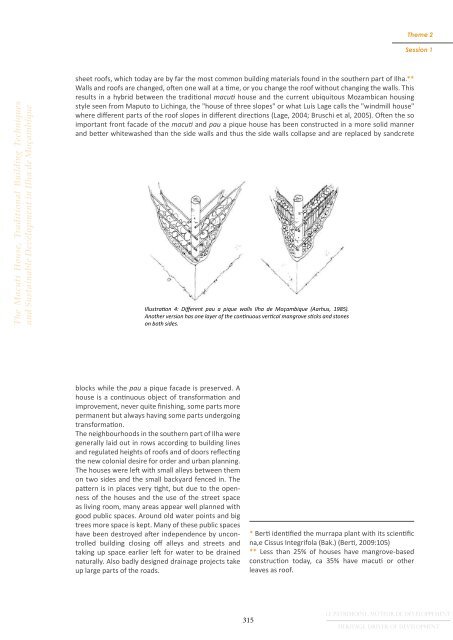PARTIE 2 - Icomos
PARTIE 2 - Icomos
PARTIE 2 - Icomos
You also want an ePaper? Increase the reach of your titles
YUMPU automatically turns print PDFs into web optimized ePapers that Google loves.
Theme 2<br />
Session 1<br />
The Macuti House, Traditional Building Techniques<br />
and Sustainable Development in Ilha de Moçambique<br />
sheet roofs, which today are by far the most common building materials found in the southern part of Ilha.**<br />
Walls and roofs are changed, often one wall at a time, or you change the roof without changing the walls. This<br />
results in a hybrid between the traditional macuti house and the current ubiquitous Mozambican housing<br />
style seen from Maputo to Lichinga, the "house of three slopes" or what Luís Lage calls the "windmill house"<br />
where different parts of the roof slopes in different directions (Lage, 2004; Bruschi et al, 2005). Often the so<br />
important front facade of the macuti and pau a pique house has been constructed in a more solid manner<br />
and better whitewashed than the side walls and thus the side walls collapse and are replaced by sandcrete<br />
Illustration 4: Different pau a pique walls Ilha de Moçambique (Aarhus, 1985).<br />
Another version has one layer of the continuous vertical mangrove sticks and stones<br />
on both sides.<br />
blocks while the pau a pique facade is preserved. A<br />
house is a continuous object of transformation and<br />
improvement, never quite finishing, some parts more<br />
permanent but always having some parts undergoing<br />
transformation.<br />
The neighbourhoods in the southern part of Ilha were<br />
generally laid out in rows according to building lines<br />
and regulated heights of roofs and of doors reflecting<br />
the new colonial desire for order and urban planning.<br />
The houses were left with small alleys between them<br />
on two sides and the small backyard fenced in. The<br />
pattern is in places very tight, but due to the openness<br />
of the houses and the use of the street space<br />
as living room, many areas appear well planned with<br />
good public spaces. Around old water points and big<br />
trees more space is kept. Many of these public spaces<br />
have been destroyed after independence by uncontrolled<br />
building closing off alleys and streets and<br />
taking up space earlier left for water to be drained<br />
naturally. Also badly designed drainage projects take<br />
up large parts of the roads.<br />
* Berti identified the murrapa plant with its scientific<br />
na,e Cissus Integrifola (Bak.) (Berti, 2009:105)<br />
** Less than 25% of houses have mangrove-based<br />
construction today, ca 35% have macuti or other<br />
leaves as roof.<br />
315<br />
LE PATRIMOINE, MOTEUR DE DÉVELOPPEMENT<br />
HERITAGE, DRIVER OF DEVELOPMENT

















